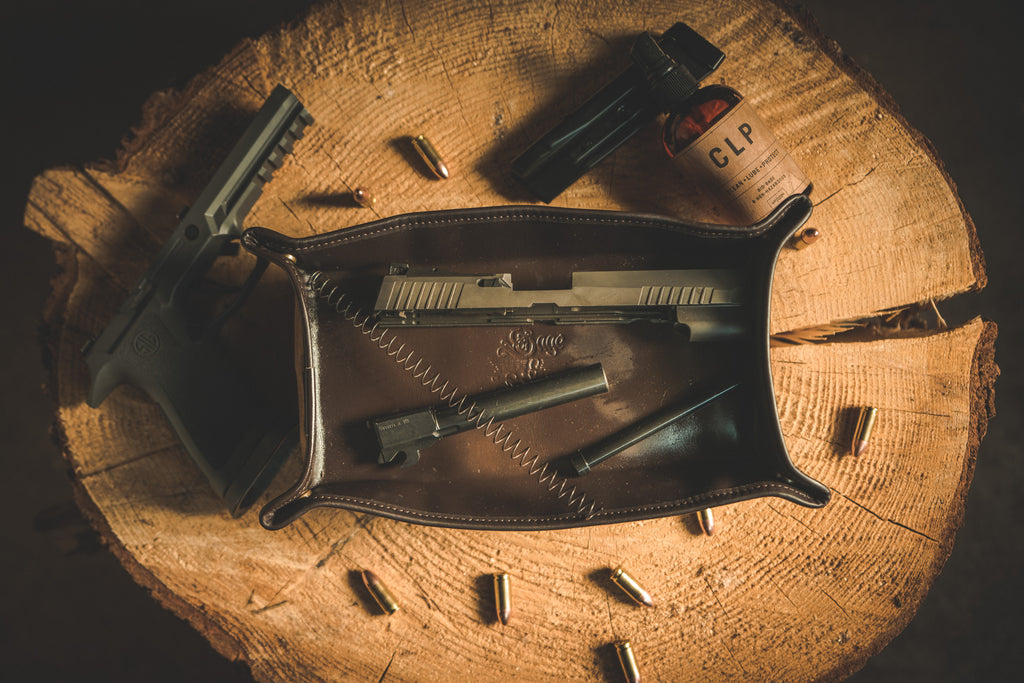Gun Cleaning Kit for a 9mm

Every firearm you own needs to be appropriately cleaned and maintained to ensure that it operates reliably. Even today, in an era of modern metals and polymers, guns need some level of care. Not only will cleaning your pistol prevent rust and corrosion, but it will also reduce wear and increase its longevity.
Why the 9mm?
If you are reading this article, you are probably one of the millions of gun owners in the U.S. who own a 9mm handgun. The 9mm has surpassed the 45 ACP and became the most popular pistol caliber for shooters. Developed in the early 1900s by Georg Luger, it soon solidified its position as a defensive handgun cartridge by being adopted as the standard military cartridge by several countries.

The popularity continually grew in the United States, the U.S. Military adopted it for their Beretta M9 in 1985. Its low recoil combined with handgun designs allowing the use of high capacity magazines made it the perfect choice for self-defense and target shooting.
A Kit to Keep Your 9mm Running Reliably
Below is a list of items to care for your 9mm. The optional add-ons are not absolutely needed, however they are extremely nice to have. All of the items listed will roll up into the Handgun Cleaning Mat, making for a nice mobile cleaning station that can be used wherever you find necessary.

Needed:
Optional Add-ons:
Pistol Cleaning Basics
Cleaning can be divided into two categories; standard and detailed cleaning. There is a pretty big difference between the two. Standard cleanings are something the user does periodically and will involve simply field stripping the gun. A detailed cleaning is reserved for the gunsmith or more experience gun owner and will require some specialized tools that will take every piece and part out.
Field stripping is a term that was coined by the military, referring to a simplified disassembly without specialized tools. This disassembly type will not involve taking every piece and part out of the gun. Instead, you will remove the few parts needed to do the standard cleaning.

Using a combination of products such as Clean+Lube+Protect (CLP) and the Brush and Pick Tool Roll Kit, clean the debris and or carbon build-up from the inside of the gun. Spray the internal parts with the CLP and give it a minute or two to penetrate into fouling. Scrub the inside using one of the nylon brushes found in the tool roll kit. Wipe away the debris with a q-tip or one of the longer firearm cleaning swabs. Once everything is cleaned, lubricate the friction points of the firearm. These friction points are often outlined in your owner's manual.
Before reassembly, clean the bore. The bore can get fouled up after a day at the range and can quickly be remedied by running a bore snake through it. A bore snake is essentially a braided rope that is designed to fit tightly in the bore, scrubbing it clean as it is pulled through. In addition, they have a brass brush built into the design to break down any heavy fouling.

Lastly, after reassembling the firearm, give the metal parts a quick wipe down with a lightly oiled rag or cleaning cloth. Metal parts are subject to corrosion or rust, and depending on the type of finish on the metal parts, they may need to be oiled regularly. If you are unsure about the level of rust prevention the finish of your firearm offers, a light coat of oil won’t hurt.
A standard cleaning is not needed after every trip to the range. Many times locking the slide back and pulling a bore snake through the barrel followed by a quick wipe down with a rag will suffice.
Disassembly and Cleaning Tips
It is no secret that there are many handguns options on the market. Unfortunately, no two are the same, and each has its own recommended procedure for maintenance. We have a growing library of handgun cleaning videos that show you how to break down and clean various types of firearms. Have a look here and see if your particular pistol model is in there. If you’ve never disassembled a firearm before, it can be intimidating; here are a few tips to follow to ensure you aren’t taking a trip to the gunsmith the first time you disassemble your pistol.

1. Make Sure it is Unloaded…
This might be self explanatory but it needs to be emphasized. Remove the live ammo from your cleaning area ensuring you don’t have a negligent discharge.
2. Refer to your owner’s manual.
I know this isn’t sexy to say, but they are very practical, and most will give you detailed field stripping instructions as well as points of lubrication. Unlike user manuals of many other products we use today, firearms manuals tend to be full of good information to help familiarize yourself with your new purchase.
3. Start at a clean workspace.
When disassembling a firearm, always start with a clean work area. Whether you're working on your dining room table or garage workbench, clear it of any clutter before cleaning. Clearing your workspace does a couple of things for you: First, you are less likely to misplace any small parts this way, as they will always be in sight. Second, you don’t want to introduce any dust or debris into the gun. If cleaning out in the garage, brush the sawdust off the bench before starting. The handgun cleaning mat does a great job of creating a clean work area while also protecting the finish of your coffee table from scratches and dents.
4. Use the right tools for the job.
If your manual recommends using a specialized tool for disassembly, use it. These tools are made to ease disassembly and avoid mechanical and cosmetic damage to the firearm. Today, many handguns are designed to be field stripped without any special tools, making it easy for the user.
5. Have a parts container nearby.
There are a lot of small parts that make a firearm function as intended. Unfortunately, these small parts will find their way onto the floor when you least expect it, inevitably leading to marathon searches on your hands and knees looking for that little piece. One way to prevent this is by using a parts tray. This can be in the form of an old plastic container or one of Sage & Braker’s firearms parts trays. This tray should have sides and should not tip over easily. It should also be something that you don’t mind getting CLP on as you will oil your parts inside the tray.
6. Don’t dread the maintenance!
Firearms are tools. Tools are best used by people who have a complete understanding of them. So take this time to learn and better comprehend how that particular firearm works. It should be taken seriously but be fun as well.
A quick search of “How to Clean a Pistol” will yield endless results, ultimately leaving the new gun owner more confused than they started. You have to be more specific when searching for information about your pistol. Search for instructions on the specific model that you are cleaning. That should include the manufacturer's name as well as the model, followed by either “field stripping” or “detailed cleaning,” depending on what you are trying to accomplish. Again, Sage & Braker has quite a few videos on specific models that you can find on our website or on our YouTube page. Have a look there or simply search for your specific model on Youtube.
